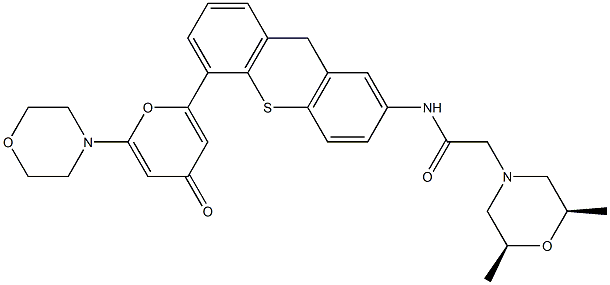Description
KU-60019 is an improved analogue of KU-55933, with IC50 of 6.3 nM for ATM in cell-free assays, 270- and 1600-fold more selective for ATM than DNA-PK and ATR,and is a highly effective radiosensitizer.
In vitro
Compared to KU-55933, KU-60019 is an improved more water-soluble inhibitor of the ATM kinase, while displaying similar target selectivity. KU-60019 has little activity against DNA-PKcs and ATR with IC50 values of 1.7 μM and >10 μM, respectively, as well as 229 other protein kinases such as PI3K, mTOR and mTOR/FKBP12. KU-60019 displays 3- to 10-fold more potency than KU-55933 at blocking radiation-induced phosphorylation of key ATM protein targets such as p53, γ-H2AX, and CHK2, in human glioma U87 and U1242 cells, as 1 μM of KU-60019 significantly induces >70% decrease of p53 (S15) phosphorylation to which extent ~10 μM of KU-55933 is required to achieve. KU-60019 effectively radiosensitizes human glioma cells with dose-enhancement ratio of 1.7 and 4.4 at 1 μM and 10 μM, respectively, and also radiosensitizes the normal fibroblasts but not the A-T fibroblasts. KU-60019 treatment (3 μM) blocks basal and insulin-induced AKT S473 phosphorylation by 70% and ~50%, respectively, and completely reduces radiation-induced AKT phosphorylation below the level of control. The effect of KU-60019 on AKT S473 phosphorylation can be seen in glioma cell lines and normal fibroblasts but not in A-T (h-TERT) cells, and can be significantly blocked by phosphatase inhibitor okadaic acid, suggesting a critical role of ATM kinase in regulating AKT phosphorylation via unknown phosphatase. Consistent with the inhibition of prosurvival AKT signaling, KU-60019 at 3 μM significantly inhibits migration and invasion of human glioma U87 cells by >70% and ~60%, respectively, as well as U1242 cells by >50% and ~60% respectively.
In vivo
In orthotopic glioma U1242/luc-GFP xenograft models, the combination of KU-60019 and radiation significantly increases survival of mice than KU-60019 alone, radiation alone, or no treatment. In addition, p53-mutant gliomas is much more sensitive to KU-60019 radiosensitization than wild-type glioma.

 China
China






